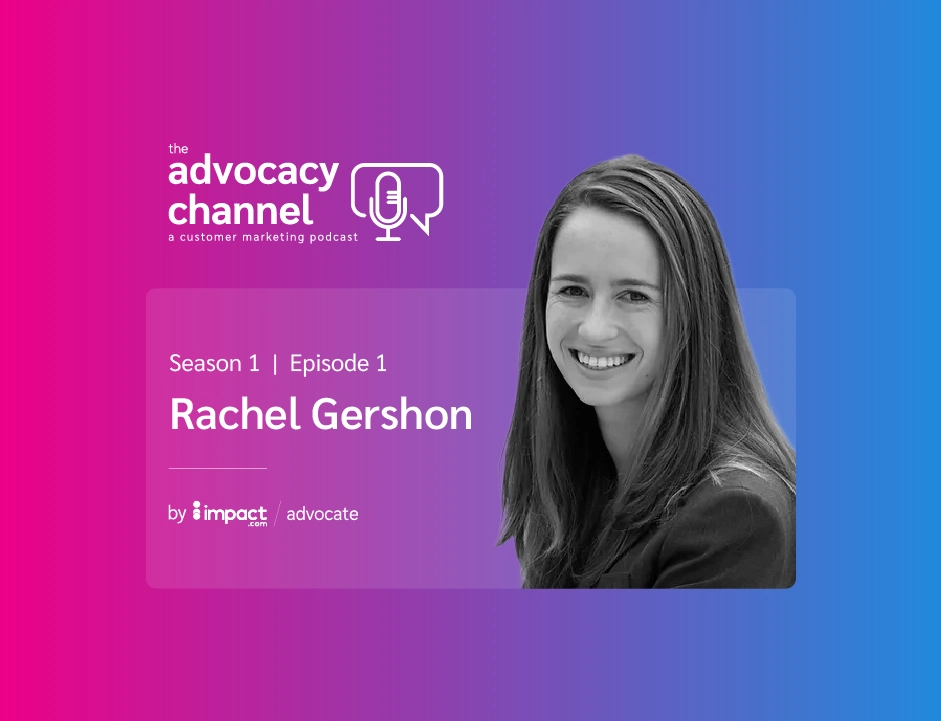When designing a referral program, conventional wisdom suggests rewarding your existing customers for bringing in new business.
But through a series of field experiments and laboratory studies, Dr. Rachel Gershon and her research team at UC San Diego have challenged this assumption, finding that giving the reward to the friend being referred might actually be more effective—and could even cost your business less.
Episode feature
This article is based on insights from the Advocacy Podcast by impact.com, Episode: “Optimizing Referral Reward Structures with Rachel Gershon.” Dr. Rachel Gershon, assistant professor at UC San Diego, shares groundbreaking research on referral program design and effectiveness.
Understanding the two-stage referral process
“There’s two steps to the process,” explains Dr. Rachel Gershon, assistant professor at UC San Diego.
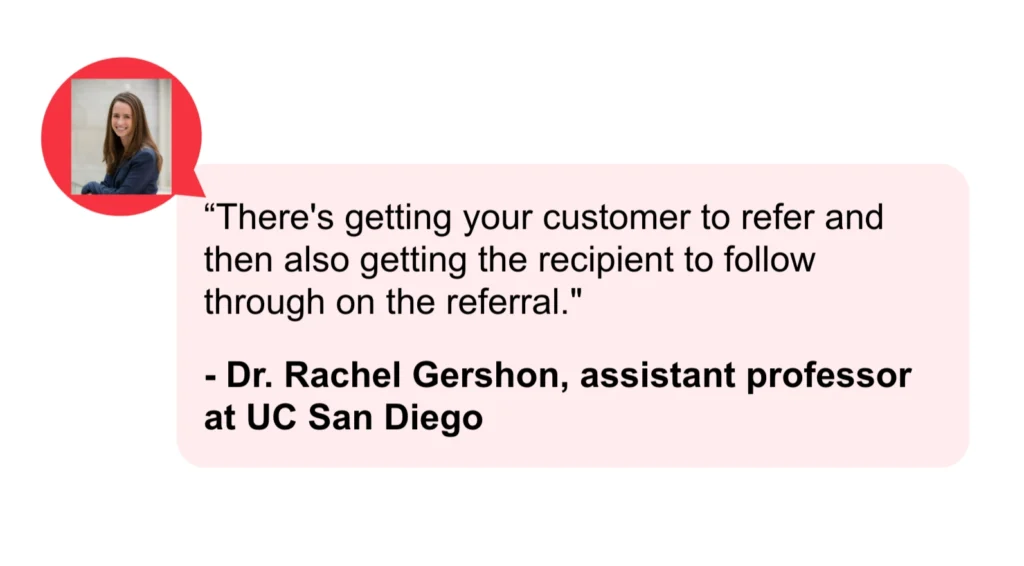
This distinction is crucial because most businesses focus heavily on motivating their current customers to make referrals, potentially missing half of the equation. To understand why this matters, let’s break down each stage:
Stage 1: Initial referral decision
The decision to refer someone involves two potential motivating factors:
- Direct reward (what the referrer receives)
- Reputational benefit (how making the referral affects their relationship with friends)
Surprisingly, research shows that customers are equally likely to make referrals whether they receive the reward themselves or their friend gets it. As Dr. Gershon explains:
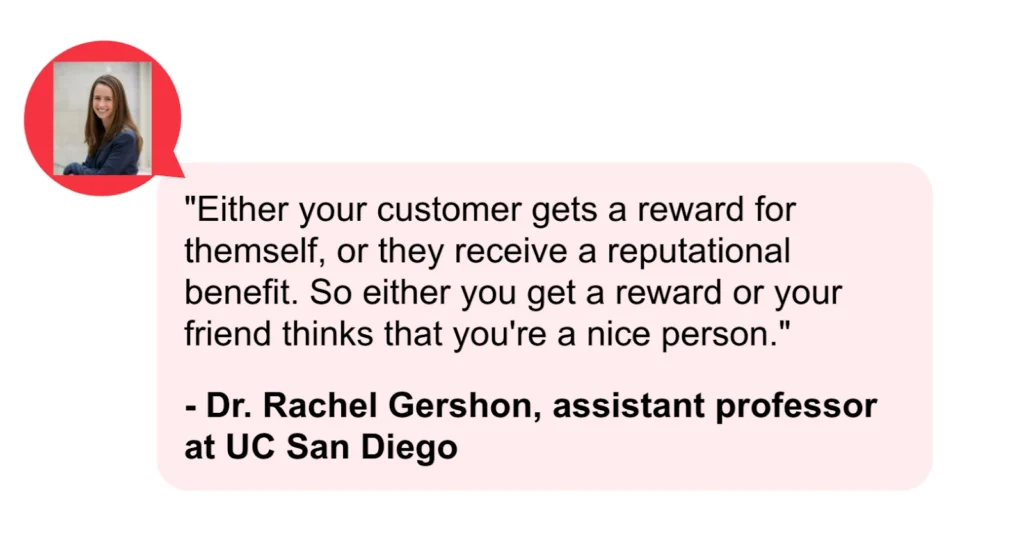
Stage 2: Recipient conversion
This is where things get interesting. The research reveals that recipients have “the harder job” in the referral process. They need to:
- Take action on the referral
- Sign up for a new service or make a purchase
- Overcome existing habits or preferences
Because of this higher barrier to action, incentives play a more crucial role in recipient behavior. “The recipients have that harder job,” notes Gershon. “Because the recipients have that harder job, the incentive is more important on their side.”
3 key referral reward structures and their impact
Understanding how different reward structures affect both stages of the referral process is essential for optimizing your program. Let’s examine the three main approaches:
Prosocial (recipient-only) rewards
In this structure, only the new customer (recipient) receives the reward. The research shows this approach can be just as effective as traditional reward structures, while potentially costing less. In fact, one working paper found that even when compared to shared rewards that cost twice as much, recipient-only rewards performed similarly well.
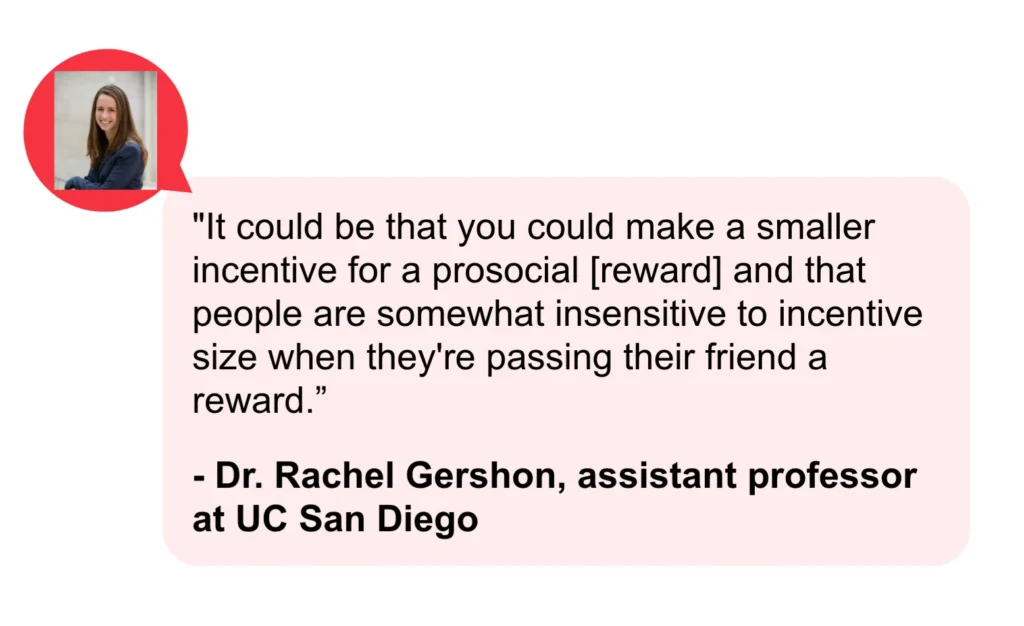
Selfish (referrer-only) rewards
The traditional approach of rewarding only the referrer can work, but it misses an opportunity to motivate the recipient. While this structure might drive initial referral attempts, it could lead to lower conversion rates since the recipient has no additional incentive to act.
Double-sided rewards
Offering rewards to both parties remains a popular choice, though the research suggests it might not always be necessary. However, double-sided rewards can be particularly effective in certain contexts, such as:
- Financial products where monetary incentives align with the service
- Complex purchases requiring more commitment from both parties
- Situations where building long-term advocacy is a priority
How to structure your referral program rewards: Key strategies and considerations
The research provides compelling evidence for recipient-focused rewards, but how do you implement this? Let’s explore the key considerations for implementing an effective referral program.
When to offer rewards: Timing matters
One of the most surprising findings from the research is that timing can significantly impact the quality of referrals. “We found something similar with a large field partner where we were excited to see most referrals happen within the first few weeks of joining the service,” Gershon explains. “But those are not the most valuable referrals.”
Key timing considerations include:
- Waiting until customers have experienced your product’s value
- Allowing time for customers to identify appropriate friends to refer
- Ensuring referrers can speak authentically about your offering
“Some companies like Blue Apron doesn’t offer the ability to refer unless you use the product for a while,” notes Gershon. This strategic delay can lead to higher-quality referrals and better long-term customers.
Testing and optimization
Research shows that experimentation is crucial for finding the right reward structure for your specific context. Dr. Gershon recommends the following:
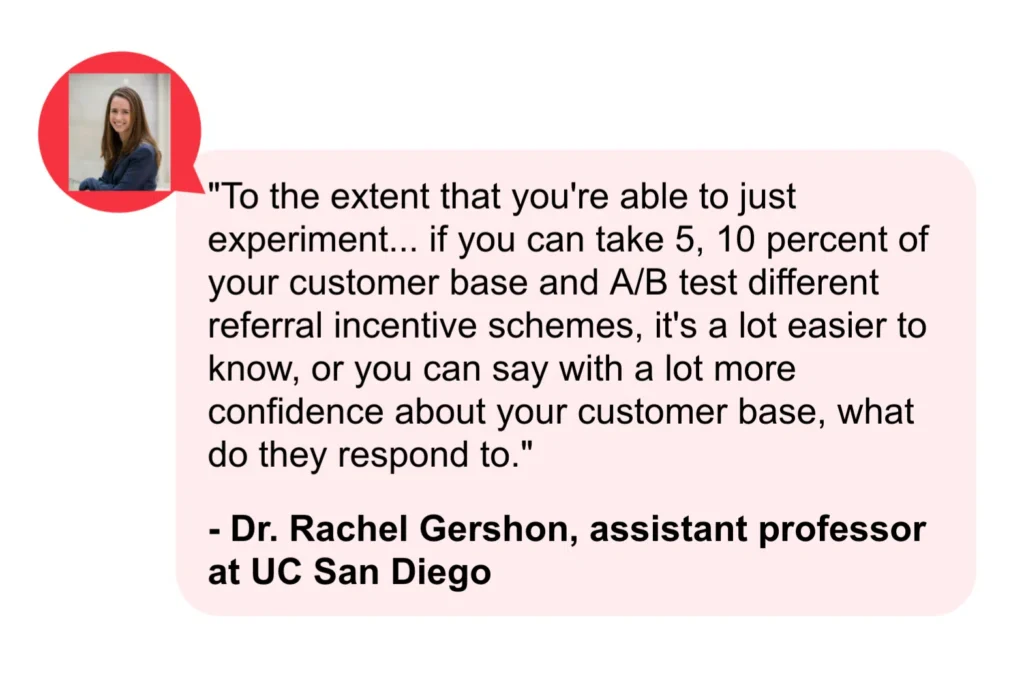
Key elements to test include:
- Reward structures (recipient-only vs. double-sided)
- Reward timing
- Incentive amounts
- Communication methods
Special considerations for different contexts
While recipient-focused rewards proved effective across multiple studies, certain situations may require unique approaches:
- Financial services: The research indicates that cash-based incentives can be particularly effective for financial products, where customers are already thinking about monetary value.
- High-value services: For significant purchases or commitments, Gershon notes there may be a threshold where reward size becomes more important: “I could imagine that there is a boundary at which point, like okay, why does my friend get 500 for joining this apartment building or becoming an employee at this company and I received nothing.”
- Charitable components: While donation-based incentives might seem appealing, the research found them less effective than direct rewards. However, they might work better when aligned with your brand’s existing charitable focus.
Action plan: Implementing your research-backed referral program
The research presents a compelling case for rethinking traditional referral structures, but implementation requires careful planning. Here’s how to put these insights into action.
Getting started: Setting up for success
Before launching your program, consider these key elements:
- Define your goals
- Determine primary objectives (acquisition, loyalty, brand awareness)
- Set measurable targets for referral conversion rates
- Establish clear success metrics
- Choose your reward structure
Based on the research, consider starting with a recipient-focused reward, especially if:
- You’re looking to optimize conversion rates
- Program costs are a significant concern
- Your product requires significant recipient action
“We provide leads and support, like everybody else. But we really want the agent to be able to run their business on our platform,” a field study participant noted, highlighting the importance of empowering new customers to take action.
Common pitfalls to avoid
The research highlighted several key mistakes that companies often make when implementing referral programs:
Early reward distribution
“Those early referrals tend to be people who want the reward,” Gershon explains, “and aren’t necessarily very familiar with the product, don’t know which friends to refer.”
To avoid this:
- Consider implementing a waiting period before allowing referrals
- Ensure customers have experienced your product’s value
- Focus on quality over quantity in early referrals
Overcomplicating the process
The research shows that conversion rates improve when you remove barriers to action. Keep your program simple by:
- Making reward structures clear and straightforward
- Reducing steps in the referral process
- Providing clear instructions for both parties
Ignoring long-term value
“We found that just the act of referring makes people more committed to the company,” Gershon notes. This suggests referral programs can drive loyalty beyond immediate acquisitions.
Consider tracking:
- Referrer retention rates
- Referred customer lifetime value
- Overall program ROI beyond initial conversion
Looking ahead: The future of referral marketing
The research suggests we’re just beginning to understand the full impact of referral program design. As Gershon points out:
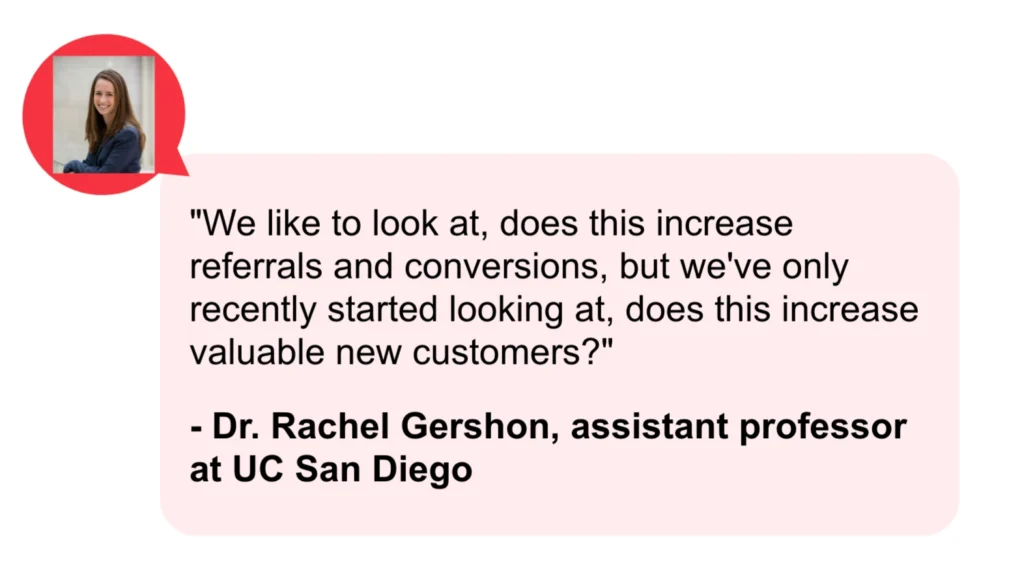
This evolving understanding points to exciting possibilities for the future of referral marketing, where programs might be:
- More precisely targeted to specific customer segments
- Better timed throughout the customer lifecycle
- More effectively balanced between immediate conversion and long-term value
Taking the next step with your referral program
The research is clear: recipient-focused rewards can drive better conversion rates while potentially lowering program costs. But like any marketing initiative, success lies in the details of implementation, testing, and optimization.
Ready to put these insights into action? While this article provides a research-backed foundation for your referral program strategy, implementing these findings requires the right technology and support.
The impact.com/advocate solution helps brands build and scale successful referral programs using these proven principles. Our platform makes it easy to test different reward structures, track program performance, and optimize for the best results.
Start building a more effective referral program today. Learn how impact.com/advocate can help you implement these research-backed strategies and drive sustainable growth through customer referrals.
Want to learn more about how customer referral and loyalty strategies can grow your business? Check out these resources:
- How to win back lost customers: 7 marketing tactics that rebuild customer loyalty [blog]
- 5 successful ecommerce referral programs and why they work [blog]
- How to switch to a new referral platform in 6 easy steps [blog]
- Top 6 customer referral marketing trends your brand can leverage in 2024 [blog]
- 7 referral marketing strategies to grow your retail business [+stand-out brand examples] [blog]
- Turn delighted customers into revenue-driving advocates [ebook]
- More than a pop-up: Building a customer referral program that scales [+ the tech that drives it [blog]
FAQs:
Selecting the right incentives for your industry and customer base can make or break your referral program. You need to give away something that resonates with your existing customers and the prospects they’ll bring. It’s key to strike a balance between what customers want, and your budget, and overall business goals.
According to research by impact.com, most consumers expect a reward value of at least u003ca href=u0022https://impact.com/research-reports/state-referral-marketing-consumers-refr-rrt-adv-ed-nam-0424/?utm_source=impact.comu0026amp;utm_medium=blogu0026amp;utm_content=design-better-referral-rewardsu0026amp;utm_campaign=blog-postu0022 target=u0022_blanku0022 rel=u0022noreferrer noopeneru0022u003eu003cstrongu003e$21 u003c/strongu003eor u003cstrongu003e11 percent u003c/strongu003ediscount.u003c/au003e The most common store credit offered is u003ca href=u0022https://impact.com/research-reports/state-referral-marketing-consumers-refr-rrt-adv-ed-nam-0424/?utm_source=impact.comu0026amp;utm_medium=blogu0026amp;utm_content=design-better-referral-rewardsu0026amp;utm_campaign=blog-postu0022 target=u0022_blanku0022 rel=u0022noreferrer noopeneru0022u003eu003cstrongu003e$10u003c/strongu003eu003c/au003e—far below the 21$ that consumers expect. However, brands exceed the percentage discount expectation by offering 20 percent—9 percent more than what consumers want. To work out the type and value of rewards you need to offer, take into account your industry dynamics, budget, and feedback from customers.
Tiered programs incentivize participants to earn a range of different rewards for a range of different actions. Tiers are based on actions you want the customer or referred person to take during the referral, such as selecting a specific plan or making purchases. By offering multiple options to earn rewards, you can increase the likelihood of a referral being completed by accommodating various audiences and their needs.


